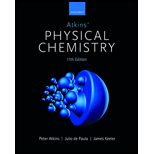
(i)
Interpretation: The proportions of gas, according to the Maxwell-Boltzmann distribution have speeds more than the root mean square speed has to be calculated.
Concept introduction: Root mean square speed is the average of squares of speed in the square root. This speed is represented as,
Where,
(i)
Answer to Problem 1B.4P
The proportion of molecules that have speed more than the mean square speed,
Explanation of Solution
The expression for the Maxwell-Boltzmann distribution is,
The proportion of molecules that have speed less than the mean square speed,
Let
Define
The identity used in the above expression is,
Substitute the equations (2) and (3) in equation (1).
The value of
Substitute the above values in equation (4).
Hence, the proportion of molecules that have speed more than the mean square speed,
(ii)
Interpretation: The proportions of gas, according to the Maxwell-Boltzmann distribution have speeds less than the root mean square speed has to be calculated.
Concept introduction: The compression factor is defined as the ratio of molar volume of a gas to the molar volume of a perfect gas. This is represented by the formula given below as,
(ii)
Answer to Problem 1B.4P
The proportion of molecules that have speed less than the mean square speed,
Explanation of Solution
The expression for the Maxwell-Boltzmann distribution is,
The proportion of molecules that have speed less than the mean square speed,
Let
Define
The identity used in the above expression is,
Substitute the equations (2) and (3) in equation (1).
The value of
Substitute the above values in equation (4).
Hence, the proportion of molecules that have speed less than the mean square speed,
(iii)
Interpretation: The proportions of gas, according to the Maxwell-Boltzmann distribution have greater and less speeds than the mean speed has to be calculated.
Concept introduction: The expression for the mean speed is derived from Maxwell Boltzmann distribution. The mean speed for the gas particles is represented as,
(iii)
Answer to Problem 1B.4P
The proportion of molecules that have speed less than the mean speed,
Explanation of Solution
The expression for the Maxwell-Boltzmann distribution is,
The proportion of molecules that have speed less than the mean square speed,
Let
Define
The identity used in the above expression is,
To calculate the proportion of molecules that have speed less than the mean speed,
Therefore,
Hence,
Hence, the proportion of molecules that have speed less than the mean speed,
Want to see more full solutions like this?
Chapter 1 Solutions
Atkins' Physical Chemistry
 ChemistryChemistryISBN:9781305957404Author:Steven S. Zumdahl, Susan A. Zumdahl, Donald J. DeCostePublisher:Cengage Learning
ChemistryChemistryISBN:9781305957404Author:Steven S. Zumdahl, Susan A. Zumdahl, Donald J. DeCostePublisher:Cengage Learning ChemistryChemistryISBN:9781259911156Author:Raymond Chang Dr., Jason Overby ProfessorPublisher:McGraw-Hill Education
ChemistryChemistryISBN:9781259911156Author:Raymond Chang Dr., Jason Overby ProfessorPublisher:McGraw-Hill Education Principles of Instrumental AnalysisChemistryISBN:9781305577213Author:Douglas A. Skoog, F. James Holler, Stanley R. CrouchPublisher:Cengage Learning
Principles of Instrumental AnalysisChemistryISBN:9781305577213Author:Douglas A. Skoog, F. James Holler, Stanley R. CrouchPublisher:Cengage Learning Organic ChemistryChemistryISBN:9780078021558Author:Janice Gorzynski Smith Dr.Publisher:McGraw-Hill Education
Organic ChemistryChemistryISBN:9780078021558Author:Janice Gorzynski Smith Dr.Publisher:McGraw-Hill Education Chemistry: Principles and ReactionsChemistryISBN:9781305079373Author:William L. Masterton, Cecile N. HurleyPublisher:Cengage Learning
Chemistry: Principles and ReactionsChemistryISBN:9781305079373Author:William L. Masterton, Cecile N. HurleyPublisher:Cengage Learning Elementary Principles of Chemical Processes, Bind...ChemistryISBN:9781118431221Author:Richard M. Felder, Ronald W. Rousseau, Lisa G. BullardPublisher:WILEY
Elementary Principles of Chemical Processes, Bind...ChemistryISBN:9781118431221Author:Richard M. Felder, Ronald W. Rousseau, Lisa G. BullardPublisher:WILEY





